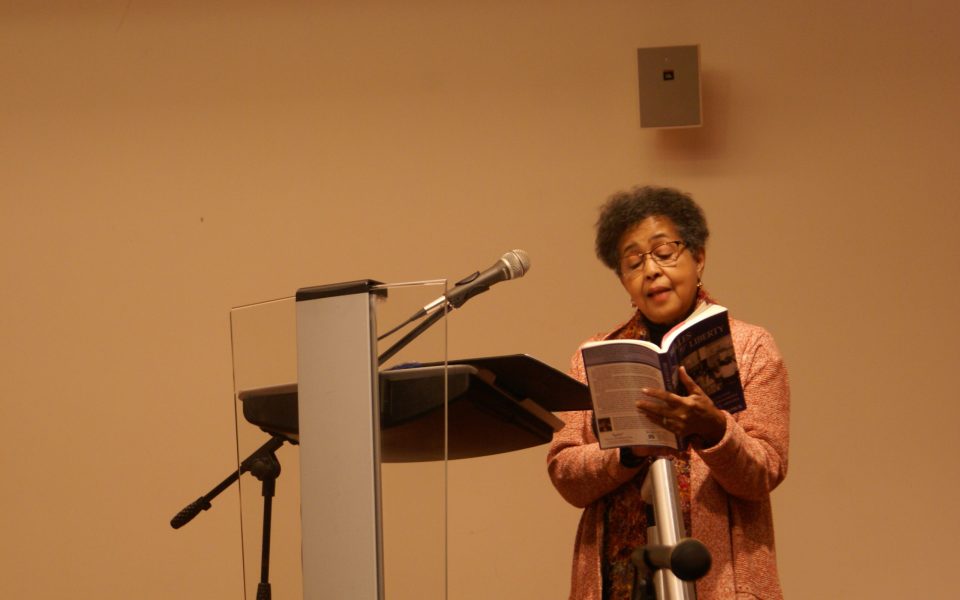Linda Brown never stands directly behind podiums.
With a stature near 5 feet tall, she says, she feels as if she would vanish. She stands to the side, ensuring neither herself nor the stories she has gathered disappear.
The Department of History at UNCG invited Linda Brown to speak at the International Civil Rights Center & Museum on a recent Saturday. With her, she brought personal accounts of Greensboro’s Central Carolina Convalescent Hospital, also known as the Old Polio Hospital, in the years when was used to detain civil rights protesters.
“It was 1963 when the Old Polio Hospital was crammed full of young people,” she recalled.
The building was not meant as a detention center. Anne Parsons, a UNCG professor of history working with graduate students on a project to bring light to the now-abandoned hospital’s past, laid out the timeline. When the polio epidemic of 1948 struck Guilford County, residents rallied funds to construct a racially-integrated center in a matter of months, which served polio-stricken patients for more than a decade.
“As I started doing research, I was literally stunned by how many people had polio or had family members who had polio,” Parsons said.
The research conducted by Parsons and students about the Old Polio Hospital led to a series of events that told the history on the eve of the building’s 70th anniversary. Outside the lecture hall, Chelsea Stewart and others raised four tall displays of photos, quotes and statistics about both the polio epidemic in Guilford and the detention of protestors.
“It’s continuing history and marking it,” Stewart explained.
Linda Brown’s speech closed the series, for the department to finalize their exhibit.
As Brown stepped onto the stage for her lecture, she carried with her a binder full of remarks and a copy of her book Belles of Liberty, both products of her own lived experiences and those of others.
Through her work, she focuses on the involvement of women during the Civil Rights movement, and believes the public should as well.
Bennett College, as she pointed out, had many students involved in the 1960 sit-ins, including herself. She clarified that Woolworth was by no means the end. In 1963, a group of mostly young students, some even high-schoolers, demonstrated for civil rights causes and desegregation of downtown Greensboro.
“It didn’t stop until the city was open in 1964,” she nodded.
The protesters organized their strategy wisely.
She waved her hands as she evokes images of the piles of handmade signs stocked on campuses, and people who signed up for shifts when they had no classes.
“We had a rotating process,” she said. “You did not leave until someone was behind you to take your seat.”
One of the goals was to overwhelm local jails, which succeeded. Then the backup facility filled. Eyes turned to a building that went vacant in the previous decade— the Old Polio Hospital.
Sandra Sharp recounted her mother’s experience teaching children, some of which became quarantined due to polio. Sharp found herself in the same hospital, now an overcrowded detainment center for students who had protested.
“We would sing, we would pray, we would rely on memory because we had exams coming up.” she said of her time in the Old Polio Hospital. “It kept us from having too much fear.”
Even with Brown’s lecture and Sharp’s account, this barely begins to sum up the vast amount of personal stories that have gone mostly unheard.
UNCG’s history department aims to change this. Throughout the course of their research and events, Parsons and her team of students worked to gather personal anecdotes and other records of the Old Polio Hospital, along with opinions on how to best convey the story. The team will then attempt to instate a highway historical marker near the site. The sign would stand roadside, and publicize the significance of the Old Polio Hospital.
Anne Parsons emphasizes that this falls perfectly within the scope of public history.
“Our mission is unearthing history and building community,” she says.
Join the First Amendment Society, a membership that goes directly to funding TCB‘s newsroom.
We believe that reporting can save the world.
The TCB First Amendment Society recognizes the vital role of a free, unfettered press with a bundling of local experiences designed to build community, and unique engagements with our newsroom that will help you understand, and shape, local journalism’s critical role in uplifting the people in our cities.
All revenue goes directly into the newsroom as reporters’ salaries and freelance commissions.


Leave a Reply